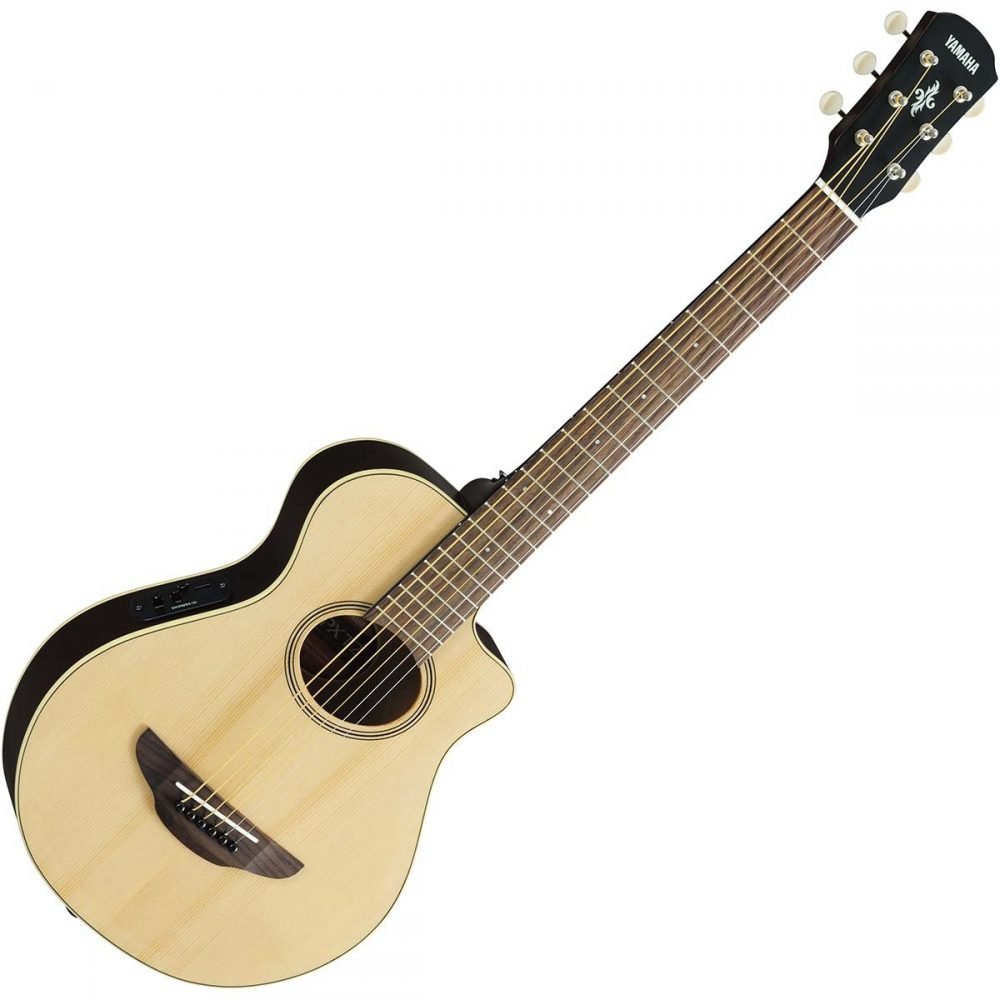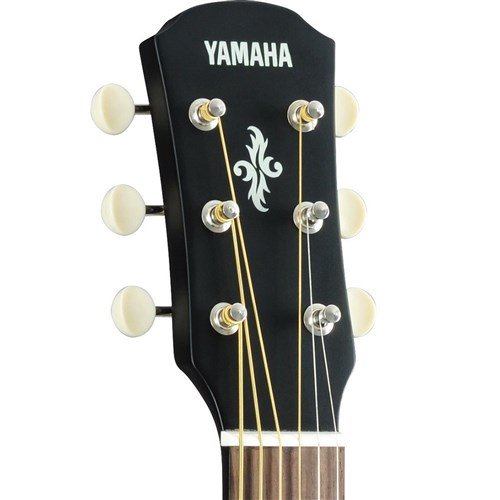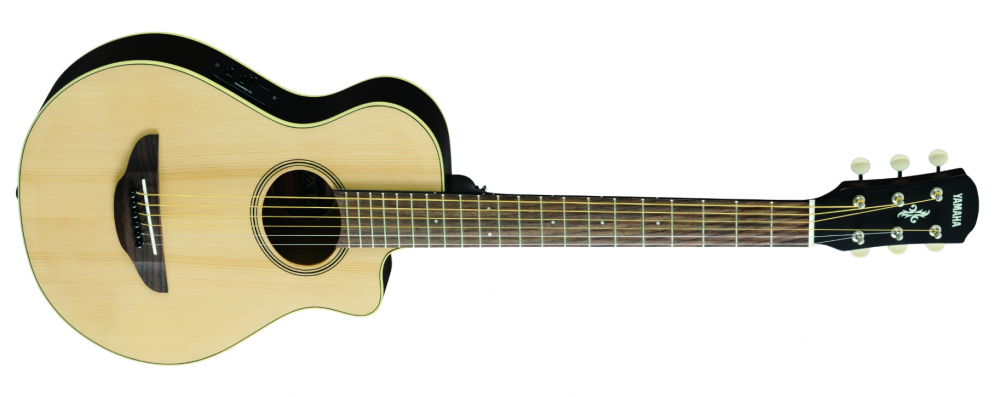A kid-friendly, wallet-friendly and travel-friendly 3/4 size guitar. These are just among the descriptions of the toned-down version of the old Yamaha APX500III – Yamaha APXT2, which perfectly fits these descriptions and more.
It’s a small-sized guitar to accommodate both kids and smaller players. However, there’s more to it than just its body style and shape.
In this review, I’ll discuss in detail the design inspiration and the materials used, the playability and the sound. To give you a complete picture of this guitar, I’ll reveal to you the good and the bad sides I saw in the Yamaha APXT2 for you to be guided.
All photos from Dawsons.co.uk, samash. Mannys.co.au
- Offered at the price you can’t beat
- Nice natural finish making the guitar looks great
- Guitar provides a perfect fit for your hands
- Strings need replacement right away to make it more playable
- You’ll get a laminate, not a solidbody
- Rosewood bridge should be replaced when using the guitar frequently
Contents
Design & Construction
Not a full-sized guitar, but a 3/4 size version of the ever-popular APX500. The APXT2 is designed to give quality and performance. It’s made of Spruce top (of course laminate), Meranti back and sides and Nato neck. Meranti is more cost-effective than mahogany, a darker wood showing off grains of wood on the glossy black finish of the guitar.
It has a single-cutaway body, oval soundhole and still has the unique APX shape, which is a thinline body shape. A well-constructed guitar, the standard neck is attached to the body at the 14th fret. This gives both small players and adult players with smaller hands the comfort when sliding up and down the fretboard.
The fretboard is made of rosewood and so is the bridge. Scaled-down in size, this has only 22.75-inch scale length, 21 total number of frets and 15.75-inch fretboard radius. The fretboard is decorated with small dot inlays.
The headstock is the typical Yamaha stuff with an inlay and Yamaha logo. This model comes with vintage-style covered tuners to ensure stability and ease when tuning and achieving the right intonation of the guitar. It has plastic nut and saddle — the ones you get for the price you pay.
As mentioned, the bridge is made of Rosewood. It’s unlikely that the bridge is made with such material, but Yamaha has its reason. Rosewood is a warm tonewood, so using it as a bridge material gives additional brightness and sharpness to the sound output. However, it’s a softer wood, too, so it wears off faster than ebony or mahogany.
In the electronics department, this affordable Yamaha still has a humble pickup to offer. It features the Acoustic Resonance Technology (ART) contact pickup which gives additional capabilities to acoustic guitars.
It has a basic control panel with a master volume and tone control knobs. This may be too basic for experienced players, but, it’s a handy control in case there’s no available sophisticated external gear. You can also take advantage of the accurate tuner present in Yamaha APXT2.
Playability & Performance
The guitar is small, yet playable. It only weighs around 5.29lbs. However, it’s also compact and solid, giving you enough support as you play even for longer hours. The neck is well-made and narrower, making it very easy to play.
For smaller hands, playing rapid rock stuff could be great. But, this will be a challenge for those with bigger hands, especially the spacing for complex picked riffs. If we talk about comfort, that’s tantamount to the evenness and smoothness of the fretboard and neck, this one gets an A+.
Since the guitar has only 3/4-size, the neck meets the body sooner, at 14th fret allowing access to the upper frets easily. It’s also a durable instrument, perfect for traveling or as a go-to instrument for any gig.
The pickups are responsive and powerful. You’ll get reverberation from the body and neck and lesser from the strings. The built-in tuner and the simple control panel with tone and volume controls also function well and are very useful. Though offered at a bargain price, everything seems to be working right out of the box.
The action is quite low, which provides ease and great playability. For better performance, I advise you to throw away the original strings (though perfectly strung) and replace them with extra light gauge strings. Even with the factory-provided strings, the simple tuners do their job well in keeping the guitar in tune for quite some time.
Sound
Now, I’ve reached the most exciting part of the review. For a guitar this small, you cannot expect it to be very powerful. In fact, it’s incomparable to a dreadnought. But, it has enough volume for practice or home performance, even when it’s not connected to an external music gear.
It has a bright tone and retains that natural sound of an acoustic guitar, especially when you connect it to an amplifier. It seems to have its unique sound — a little ukulele-ish sound, given its size and body profile.
With the right acoustic guitar amp, the sound could be strong enough for small gigs. It may take a while, though, to get used to hearing the strings when plugged in. Since it has a unique sound quality, it will grow on you sooner, as you keep on playing this small, yet able guitar.
But, wait, there’s more. Remember that it has pickups onboard? Well, the pickups are powerful and very dynamic. It’s a transducer amp because it has its very own preamp. So, you’ll get the sound more on the reverberation of the wood and neck, and less on the strings.
With the pickup, you’ll get a mellower flavoring to its sounds. With the tone and volume controls, you can shape the sound it produces to fit your preferences. Surprisingly, you can still get clear sounds from this tiny acoustic-electric guitar.
Value for Money
It’s small but terrible! From the inside out, you can see that this guitar has something unique to offer. And, indeed it has. The construction is well-thought to complement the capacity of the soundboard.
Then, you have a good tonewood for the fretboard and neck that aids the playability of this guitar. The neck meets the body at 14th fret, allowing you to get access to upper frets easily. With the reliable tuners, guitar holds tune pretty well without a problem.
Lastly, you got reliable electronics onboard — pickups and controls — that help shape the unique sound of this guitar. With all these rolled into a ¾-size guitar, it’s more than worth it.
Verdict
So much with the dreadnought, let the ¾-size guitar take over with the Yamaha APX600. Made with Spruce top and Meranti back and sides, you got a well-constructed guitar. The slim Nato neck and the rosewood fretboard provide this guitar more playability and comfort.
Although it’s already set up out of the box, it’s recommended to change the strings for better performance. Also, if you’re a professional, the onboard electronics may be too simple for you.
Setting these issues aside, this acoustic-electric guitar delivers a bright and natural tone. Whether you’re playing with or without an amp, this guitar has enough power and volume.





